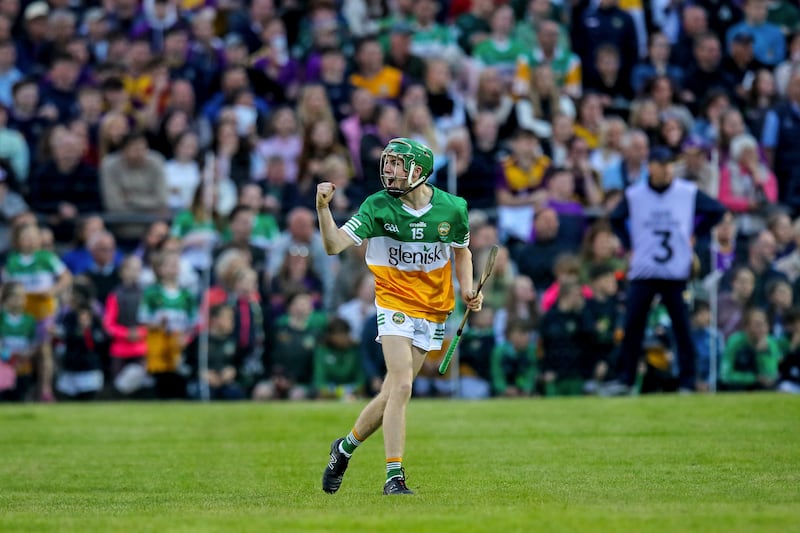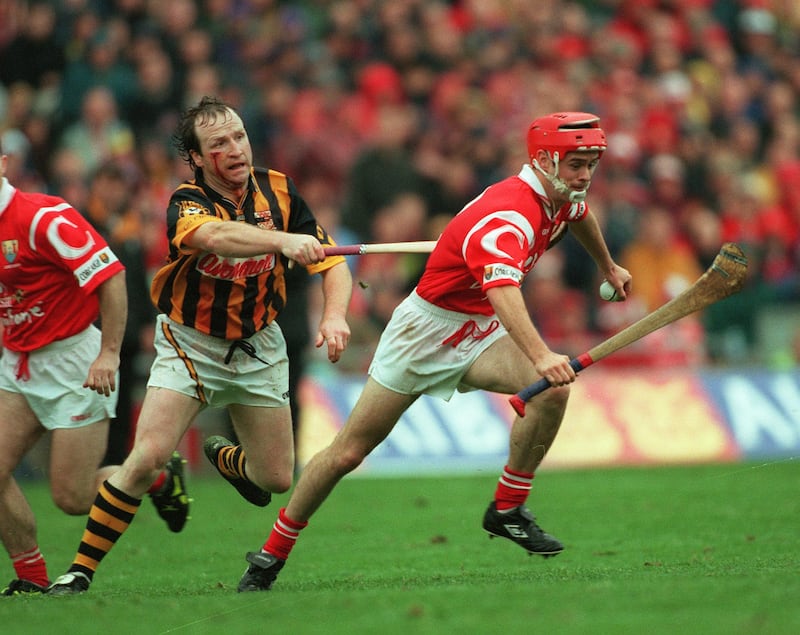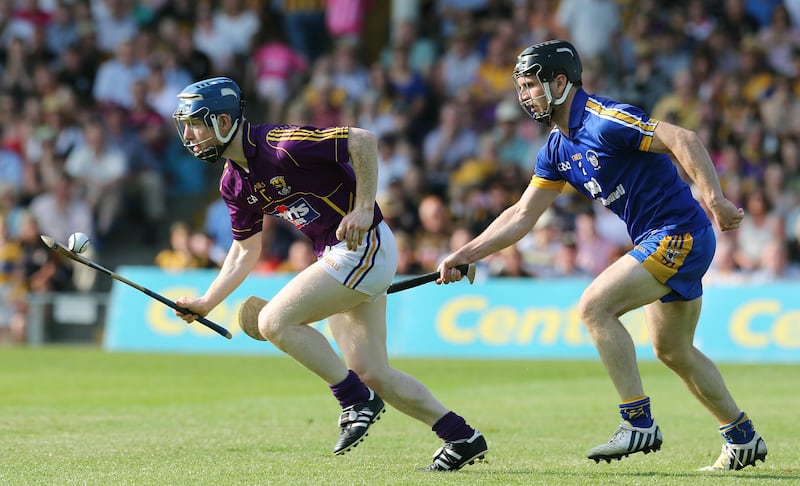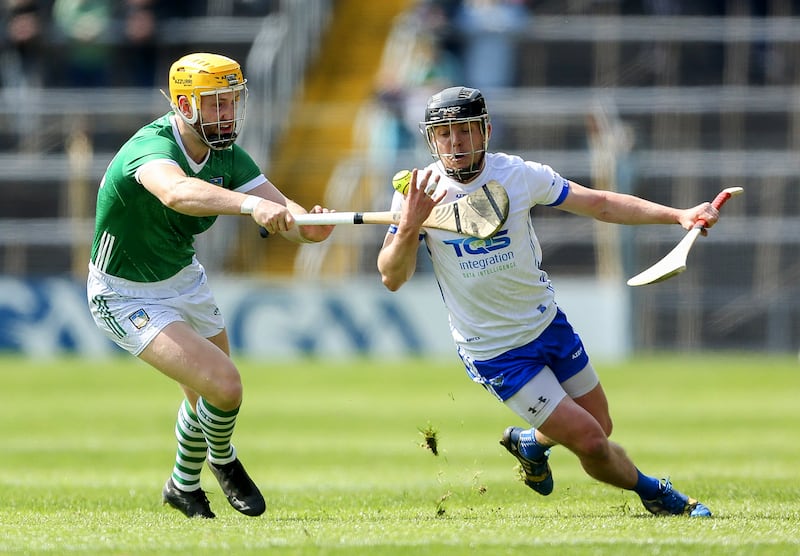In the middle of the second half last Saturday, Adam Screeney joined a scrap for the ball about 30 metres from the Wexford goal.
It was a familiar episode of fumbling and spoiling, the ball jumping like popcorn. Then, in a corner of the crowd scene, a Wexford defender wrapped his arm around Screeney’s waist, lowered his head and latched on, like it was a lineout maul. With a quick leg drive, Screeney was taken out.
It was the young Offaly wizard’s first start in a National League match, a month after his 19th birthday. With his first possession he was turned over, with his second he forced a 65, with his third, he scored. With his fourth touch he was flattened. No free. Carry on. He didn’t have the ball in his hand again for 42 minutes. Two minutes later he was replaced.
The rain spilled down, the pitch cut up, the ball did as much skidding as bouncing; there was rooting and tearing and belting, all of it in season. Screeney is a confectioner; it was a bread-and-butter day. No valid judgements could be made.
READ MORE
Over the next couple of years, though, Screeney’s progress will be an interesting test case. On Offaly’s run to the All-Ireland minor final in 2022 and the under-20 final last summer his sorcery lit up the championship: his touch, his hairpin turn, his daring, his finishing, his elusiveness. Everything about him was electrifying.
The query, though, was his size: not tall, not powerful, slight. On a hurling field, he looked like a jockey.
“I’d say he’s even too light to be a jockey,” says Johnny Pilkington, the former Offaly player who has been a selector with their minors and under-20s in recent years.
“We’re trying to put weight on him but it doesn’t seem to be kind of going on to him.”

In an interview on the Smaller Fish podcast last year the Offaly under-20 manager Leo O’Connor addressed the same question.
“He’s actually put on 7½ kilos [more than a stone] since the All-Ireland [minor] final last year and he still looks tiny. And to take the punishment he took this year and to keep coming back . . .”
He stands at 5ft 8in now and weighs about 9 stone 10lbs.
Screeney’s guts and scrappiness are not in doubt. On Saturday he stopped a Wexford defender by wrapping him up briefly and letting him go before the contact attracted the referee’s whistle. As long as he could execute the technique the disparity in size was immaterial.
“He has the tackle,” says Pilkington. “He does the hard work. There’s loads of forwards out there that will get you scores but won’t chase after a lad. He will.”
The bigger question, though, is how hurling has evolved and the kind of player it may have left behind.
Rugby used to style itself as a game for all shapes and sizes until the physical conditioning of the professional era reduced that spectrum; the scrumhalf was no longer necessarily the smallest guy, the wings were no longer skinny, the props and hooker were no longer excused from being explosive in the loose. The gym had a homogenising effect.
Hurling was like that too before its strength and conditioning revolution. Small, light, skilful players were stereotyped as corner-forwards, and in the old positional grid, they only had one man to beat.
With the right ball, they could score without having to break a tackle. Now? Every player is conditioned to break a tackle. Every coach of an elite team is looking for big, athletic men who can hurl.
That wasn’t always the case. When Cork and Kilkenny contested the All-Ireland final 25 years ago, eight of the starting forwards were less than six foot tall, four on each side. Joe Deane for Cork and Charlie Carter for Kilkenny were both 5ft 7ins; terrific hurlers and formidable competitors, but not big. Didn’t matter. In a low-scoring game, on a miserable day, Seanie McGrath scored three points in the second half, a match-winning haul. He was 5ft 8ins and 10½ stone.

Gym work had just been included in the preparation of intercounty hurling teams, but it was only a winter pursuit and there was still a large constituency of sceptics. In hurling there had always been strong men but skill and speed evened the odds. In the Cork set-up at that time, Teddy Owens brought them to the gym.
“I didn’t do much of it,” says McGrath. “I did it in the group collective sessions but, if I’m being honest, I fudged it. I gave the impression I was doing it. I was always worried that I’d lose something. I knew I’d never get strong. I’m still not strong. I was so paranoid that if I lost an ounce of pace I’d never survive.
“But I can say, throughout my career, nobody ever said to me that I needed to be stronger. Never. It was a different game. If I was playing now I probably would be told ‘You need to bulk up’. I don’t know if that would it sit well with me.”
Rory Jacob broke on to the Wexford team as a teenager in 2002, straight out of minor. He was light and small, but he was skilful and quick and accurate and those qualities trumped everything else. In the course of Jacob’s 13-year-career, though, the dial moved. From beginning to end he bulked up by about 16 pounds, primarily as a means of defence.

“A fella like me needed to do my gym work because the physicality got harder over the years,” says Jacob. “The lads playing against you got more powerful. For you to survive you had to have some sort of base. You couldn’t ignore it.
“But a lad like me – and Adam Screeney is the same – we’re not going to turn into man mountains either. I would have depended an awful lot on having a really, really good first touch and really, really good speed off the mark and I’m sure Adam is the same.”
The modern trend towards big forward lines reached an apex in the 2018 All-Ireland final. The average height and weight of Galway’s forwards that day was 6ft 2in and 14½ stone; on the Limerick side it was just over 6ft 1in and just less than 14 stone. Their physique was the frame that held the picture; every one of them was an accomplished hurler.
The interesting case, though, was Graeme Mulcahy who was the only player shorter than 6ft feet tall in either attack; he clocked in at 5ft 9in and less than 12 stone. Nearly a decade earlier he had started his intercounty career as a stereotypical corner forward, elusive and handy, feasting on loose ball and passes.

By 2018, Limerick had no interest in a player like that, no more than Brian Cody had for most of the previous 20 years. To survive in Limerick’s new order he was forced to change his game completely. A bit like Sadio Mane in his pomp under Jurgen Klopp, Mulcahy led the press from the front.
“The inside role was gone for him,” says Jacob. “He was the third man in the full-forward line, playing in front. His main role was to be the highest tackler, more than scoring or making scores. Graeme Mulcahy was getting on the Limerick team for a few years purely on his tackle count and the turnovers he was getting.”
In the 2018 All-Ireland final Mulcahy made 16 tackles, more than any other player on the pitch. That was how the game had evolved. Mulcahy was forced to adapt.
A year earlier, one of the three best players in the All-Ireland final was Jamie Barron: 5ft 9in, 12½ stone, playing centrefield for Waterford. His career had started in the corner too.
“When I put Jamie at midfield in 2015 he was deemed to be too slight for it,” says Derek McGrath, former Waterford manager. “Jamie filled out, and he’s a tank now, but he was lighter.
“I never said to him that he needed to be bigger. I never had that conversation with him. He had a sidestep, he had the ability to be evasive. Mobility was everything for us at that time. His mobility was crucial. Davy Fitzgerald did something similar with Podge Collins – relocated him to the middle third. I’m looking at Corey Dunbar Byrne playing midfield for Wexford now. He’s not a big man.
“It wouldn’t surprise me if a fella like Adam Screeney came out the field too and got on the ball maybe a bit easier. Are the smaller players being squeezed to the margins? They probably are. But there’s a place for them still.”

The emphasis on power in the modern game impacted other trends too. When minor was under-18, and before the strength and conditioning revolution, it wasn’t unusual for a really talented 19-year-old to make a breakthrough at senior intercounty level. But how many have done it in the last 10 years? Conor Whelan, Austin Gleeson, Cian Lynch. How many others?
Christy O’Connor trawled the data and found that in the 2012 championship the top nine counties had used 43 under-21 players; a decade later that number had fallen to just 15. The chasm in physicality between age-grade teams and senior hurling had become so wide that good young players couldn’t make the leap in one bound. At 19, Screeney is swimming against that tide too.
Will he break through? Pilkington is convinced of it.
“He is a genius. Some people might say, ‘Oh, he’s cocky and confident’ and the whole lot, but when it comes to the day, he does it. He’s just total hurling. He just wants to make it.”
What would it say about the modern game if Screeney fails? More power to the robots? Spare us.
- See our new project Common Ground, Evolving Islands: Ireland & Britain
- Sign up for push alerts and have the best news, analysis and comment delivered directly to your phone
- Find The Irish Times on WhatsApp and stay up to date
- Our In The News podcast is now published daily – Find the latest episode here



















